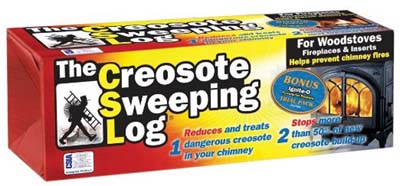Creosote Dangers Described
- Creosote Defined
- Creosote is a carbon based byproduct of burning wood and it can take the form of a solid, liquid or gas. When you burn wood in your fireplace, the chemical composition of the burning wood that does not fully combust leaves a residue behind known as creosote. You can see it as smoke when it is in its gaseous state, and then as soot on the walls of your firebox in its solid state. What you cannot see is that creosote coats the inside of your chimney liner and it is highly combustible.
Here is a before and after of a
chimney liner that is clean vs.
getting clogged with creosote.
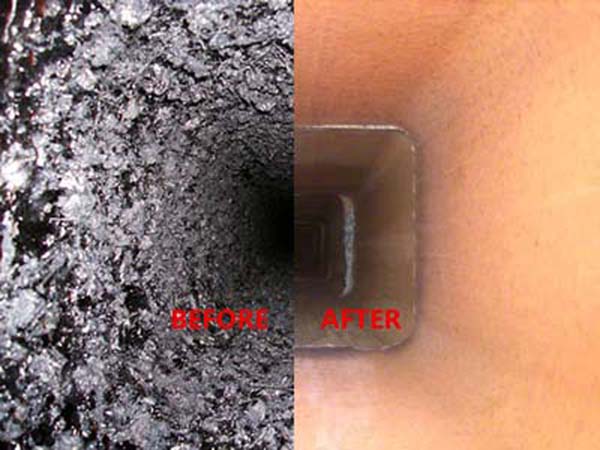
- How Creosote Build-up Occurs in
your Fireplace and Chimney or Wood
Burning Stove
- As the carbon vapors from burning wood draft up your chimney flue, the temperature cools, which converts the creosote to a drippy and sticky liquid tar substance that eventually hardens into a shiny glaze, or crunchy and porous black globs.
- Every time you start a fire, you are contributing to the accumulation of creosote on the interior of your chimney. Over the course of one winter, creosote deposits can build up to several inches thick, depending on how often you use your fireplace or wood burning stove. The increase in creosote creates a compounding problem because the deposits reduce the airflow through the chimney so it cannot draft properly to give the wood enough airflow to burn at a high enough temperature. When the fire is not hot enough, the amount of carbon increases and you get more creosote buildup on the interior of your chimney liner.
- Creosote Dangers (How
it can catch on fire in your
chimney)
- Since creosote is highly combustible, a thick accumulation creates a fire hazard. If a hot fire is built in your stove or fireplace, and the air control is left wide open, it allows hot oxygen and flames into the chimney. When hot oxygen or a spark comes in contact with creosote, it can ignite and create a chimney fire. This is what creosote looks like after catching on fire in a chimney.
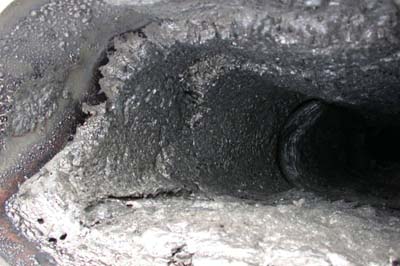
- Unsafe levels of Chimney
Creosote Explained
- Once creosote reaches a thickness of 1/8 of an inch, it is a fire hazard. You can inspect the inside of your flue from the roof and measure the thickness or better yet, have it professionally inspected by a chimney sweep. They have cameras that make it possible to see the entire interior of your flue and liner. Other signs that you have unsafe levels include smoke coming into your house, soot covering the surfaces of your living space around the fireplace, or if you see dark smoke constantly flowing from your chimney.
This picture of dark smoke indicates
a problem.
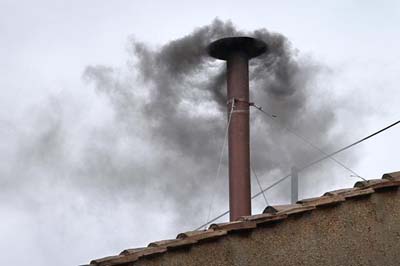
- Creosote Odor
- The closest description to creosote’s odor that most people have experienced is the smell of fresh asphalt that has just been paved and is waiting to dry. Creosote has a tar-like, corrosive smell that is easily distinguished by the human nose. If you have a buildup of creosote, it will block your flue from drafting properly which can mean you could also smell smoke in your living area when a fire is lite. An improperly drafting chimney creates the risk other harmful gases, such as carbon monoxide entering your living space. CO has no odor but is deadly, so again, a buildup of creosote is highly dangerous and needs to be cleaned before lighting any more fires.
This is what a chimney filled with
creosote looks like from the inside.
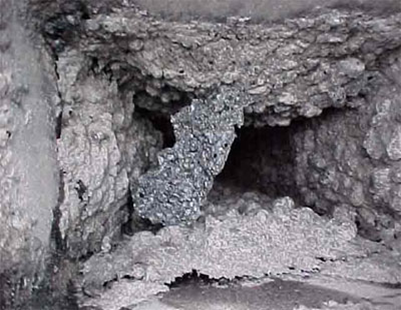
- Creosote Health Risks
- The International Agency for Research on Cancer (IARC) has determined that coal tar is carcinogenic to humans and that creosote is probably carcinogenic to humans. Most people are exposed to very low levels of creosote. You are not consuming it or letting your kids play in the fireplace so there is not much risk. People who are exposed to higher concentrations than the general population are those exposed to creosote in their jobs. Professionals such as chimney sweeps know the precautions to take and wear dust masks and safety goggles when cleaning your chimney. In general, you should not worry about health risks from exposure to creosote; however, you should worry about fire safety.
- How to Minimize Creosote in your
Chimney
- The best way to minimize creosote buildup in a wood burning chimney is to have your chimney inspected and cleaned by a chimney sweep. Another tactic to minimize creosote buildup between cleanings is to use dry wood that is at least a year old. If you are burning hot fires with dry wood, most of the material will be able combust, reducing creosote residue. Never burn trash, cardboard, or scrap lumber in your fireplace or wood burning stove. There is no way to prevent creosote from forming when you are burning a fire, but you can maintain safe levels of creosote in your chimney very well by only burning hot, dry wood and keeping an eye on the chimney. Have a chimney sweep remove it from the chimney liner and firebox as often as needed to keep it at a safe level.
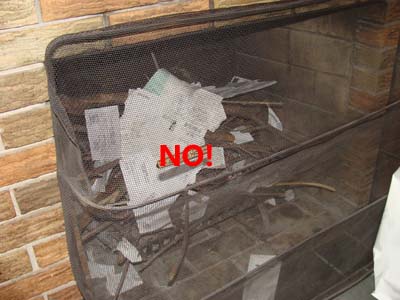
- Creosote Cleaning Logs
- Creosote sweeping logs are not a substitute for a professional inspection and cleaning however, they are an option if you are trying to minimize creosote between cleanings. They have active ingredients such as metallic chloride of sodium, trisodium phosphate (TSP), ammonium sulfate, or potassium nitrate that attach to existing creosote and dry it out, rendering it less susceptible to catching on fire. You may notice chunks of creosote falling into your firebox or landing on your damper and these should be promptly removed to maintain a proper draft.
